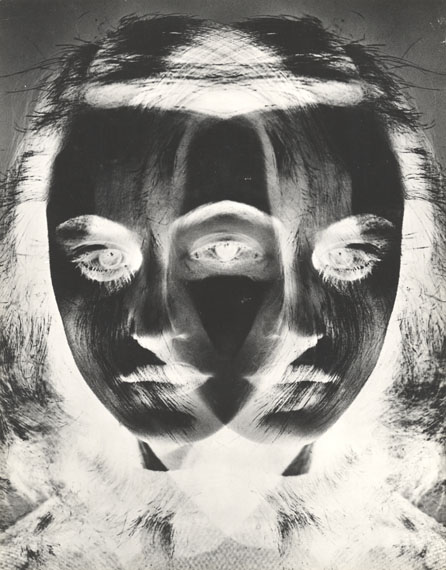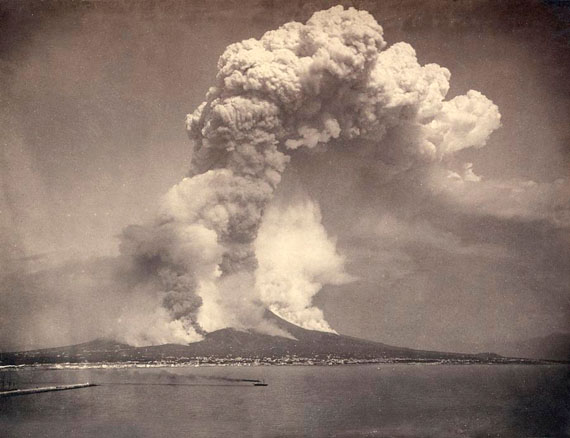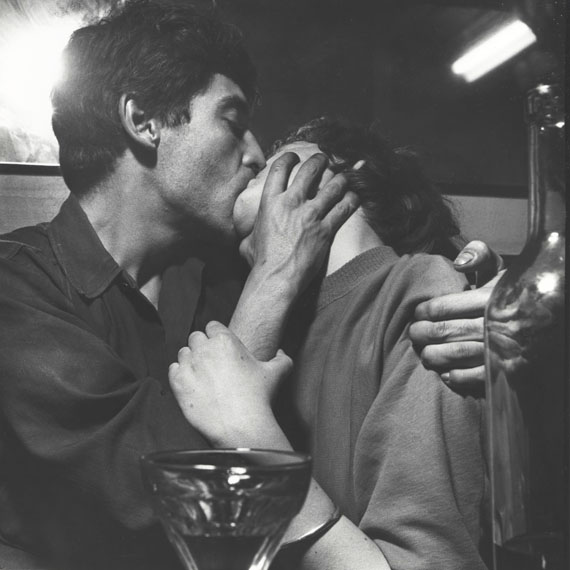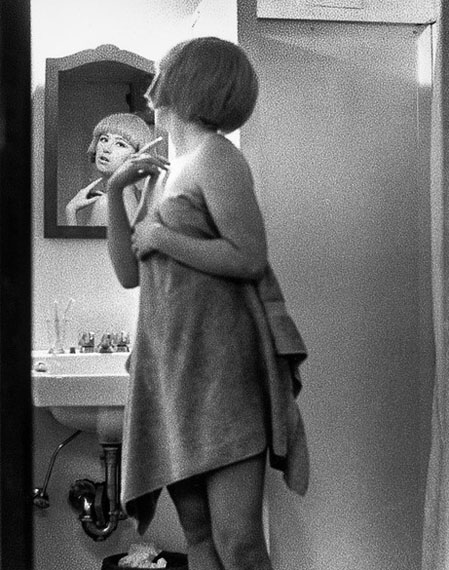
The Moment is Eternity
Works from the Olbricht Collection
Diane Arbus » Tina Barney » Robert Capa » Henri Cartier-Bresson » Larry Clark » Philip-Lorca diCorcia » Rineke Dijkstra » Robert Doisneau » William Eggleston » Elger Esser » Louis Faurer » Lee Friedlander » André Gelpke » Paul Graham » Jitka Hanzlová » Zoe Leonard » Robert Mapplethorpe » Lisette Model » Eadweard J. Muybridge » Helmut Newton » Nicholas Nixon » Gerhard Richter » August Sander » Cindy Sherman » Giorgio Sommer » Otto Steinert » Bert Stern » Juergen Teller » Wolfgang Tillmans » Ed van der Elsken » & others
Exhibition: 26 Sep 2018 – 1 Apr 2019

"The Moment is Eternity"
Works from the Olbricht Collection
Exhibition: 26 September 2018 – 1 April 2019
In the context of Berlin Art Week 2018 and of EMOP Berlin – European Month of Photography.
With some 300 works by approximately 60 artists on display, "The Moment is Eternity" shines the spotlight on the photographic works in the Olbricht Collection, showing them in dialogue with other artworks from the collection, as well as artefacts from the Wunderkammer.
Transience is one of the key themes of the Olbricht Collection. And what artistic medium other than
photography could be better suited to addressing the questions of time and history that this theme throws
up? Lending duration to the moment is inscribed into the very medium itself. In this property, art and
philosophy come together. Ever since Antiquity, eternity has been described as timeless, and it is in this sense that Goethe equates the moment with eternity in his poem 'Vermächtnis' (Legacy, 1830). For humanity, the moment is the only perceptible slice of eternity.
Goethe’s 'legacy' is to shape the world through sensuous and reasoned perception: Jumping ahead through the epochs, this fits together with Henri Cartier-Bresson’s dictum of the ‘decisive moment’ to describe an art that is able to simultaneously capture the essence of an event and the form that corresponds to that essence. Just as the photographic grasp on reality intensifies the signs and symbols of an era, the interplay of other art forms also reflects diverse aspects such as duration and transience. The expansive range of the Olbricht Collection explores such themes as beauty and sensuousness, becoming and disappearing, and the body and society, as manifested in various epochs and media.
Photography’s replication of reality is only apparent. From documentation to self-reflection, it provides information about the human condition and about society through the ages. With his epochal study on 20th-century humanity, August Sander provides an example of how a belief in the factual force of the photographic image combined with the comparative faculty of sight can generate a binding social typology. Collecting and preserving is not just the business of scientists, or that which is revealed in the sedimentary deposits of cells (as in the shell of a turtle), it also describes the practice of a contemporary artist like Nicholas Nixon, with his visualization of time passing like sand through an hourglass in his Brown Sisters.
Images and reflections, projections and interrogations of self, play a major part here. It is not just the the reflective surface of the gelatin silver photograph which Otto Steinert emphasizes in his negative doubleheaded portrait of a woman that holds up an image of its age to the viewer, but also the cultural history of roles and rituals that Cindy Sherman dramatizes, or that Lee Friedlander captures in the form of a laconic self-portrait. The immediacy of a direct interlocutor is another aspect that we find in a number of these works, for example in the monumental Photo Realism of a Franz Gertsch, the Expressionist, evocative art of Emil Nolde, or in André Gelpke’s confrontation with the red light district.
Contemporary painting has found powerful instruments in its engagement with the procedures of
photography and the appropriation of historically charged images from the media, as is evidenced in the
nudes of Gerhard Richter or Marlene Dumas. These are juxtaposed with depictions of bodies by artists such as Otto Steinert or Helmut Newton, which reflect the aesthetics of their age in distilled form. The motif of the Ecce Homo also recurs through the centuries in numerous, fragmentary variants – from Dürer’s Sebastian through to the exposed body of the model Kristen McMenamy – inspiring photographers from Helmut Newton to Juergen Teller.
Photographic vision is comparative vision. In keeping with this, Annette Kicken has cast her own,
comparative eye on the diverse Olbricht Collection, identifying items that fit together to form a series of motifs, subject matter, gestures and artefacts that evoke sympathetic reverberations through their
overlaps and analogies. They demonstrate how the most divergent things can enter into a relationship
with one another. It’s just a matter of finding the right moment.
Curated by Annette Kicken.�

"The Moment is Eternity"
Works from the Olbricht Collection
Ausstellung: 26. September 2018 bis 1. April 2019
Im Rahmen der Berlin Art Week 2018 und des EMOP Berlin – European Month of Photography.
"The Moment is Eternity" lenkt mit rund 300 ausgestellten Werken und Objekten von rund 60 KünstlerInnen das Augenmerk auf die fotografischen Arbeiten der Olbricht Collection und zeigt sie im Dialog mit anderen Kunstwerken der Sammlung sowie Artefakten der Wunderkammer.
Zu den programmatischen Schwerpunkten der Olbricht Collection gehört das Thema Vergänglichkeit. Welches andere künstlerische Medium als die Fotografie wäre besser geeignet, die daraus entstehenden Fragen von Zeit und Geschichte zur Diskussion zu stellen? Dem Augenblick Dauer zu verleihen, ist dem Medium per se eingeschrieben. Hier berühren sich Kunst und Philosophie: Seit der Antike wird die Ewigkeit als zeitlos beschrieben, und in diesem Sinn setzt Goethe in dem Gedicht "Vermächtnis" (1830) Augenblick und Ewigkeit gleich. Der Moment ist für den Menschen der einzig wahrnehmbare Teil der Ewigkeit.
Die Welt sinnenhaft und vernunftbegabt wahrnehmend zu gestalten, ist Goethes "Vermächtnis": es fügt sich mit Henri Cartier-Bressons Diktum des 'entscheidenden Augenblicks' (the decisive moment) über Epochengrenzen hinweg zur Beschreibung einer Kunst, die die Essenz eines Geschehens und die ihr angemessene Form in eins zu fassen vermag. Wie der fotografische Zugriff auf die Wirklichkeit die Zeichen einer Zeit verdichtet, so reflektieren auch die anderen Künste im Zusammenspiel vielfältige Aspekte wie Dauer und Vergänglichkeit. Schönheit und Sinnlichkeit, Werden und Vergehen oder Körper und Gesellschaft werden innerhalb der großen Bandbreite der Olbricht Collection in verschiedenen Epochen und Medien gezeigt.
Die Fotografie verdoppelt die Wirklichkeit nur scheinbar. Von der Dokumentation zur Selbstreflektion
ermöglicht sie Aufschluss über die Bedingtheit des menschlichen Lebens und die Gesellschaft in
verschiedenen Epochen. August Sander ist mit seiner epochalen Studie über die Menschen des 20. Jahrhunderts ein Beispiel dafür, wie das Vertrauen in die faktische Kraft des fotografischen Bildes mit dem vergleichenden Sehen eine verbindliche soziale Typologie hervorbringt. Sammeln und Bewahren ist nicht nur Aufgabe des Naturforschers oder offenbart sich in den Ablagerungen von Zellen, etwa im Schildkrötenpanzer. Auch ein Zeitgenosse wie Nicholas Nixon, der mit seinen Brown Sisters das Vergehen der Zeit wie die Sanduhr visualisiert, reiht sich in diese Praxis ein.
Bildnis und Spiegelbild, Inszenierung und Selbstbefragung nehmen eine Schlüsselrolle ein. Nicht nur
der Spiegel des fotografischen Silberbilds, den Otto Steinert im Umkehrbild des doppelköpfigen Frauenbildnisses betont, auch die Kulturgeschichte von Rollen und Ritualen, wie sie Cindy Sherman in Szene setzt oder Lee Friedlander als lakonisches Selbstbild fixiert, halten dem Betrachter den Spiegel ihrer Zeit vor. Die Unmittelbarkeit eines direkten Gegenübers zeigen sowohl der monumentale Fotorealismus eines Franz Gertsch wie auch die expressionistische Ausdruckskunst von Emil Nolde oder die Konfrontation mit dem Rotlichtmilieu bei André Gelpke.
Die Malerei der Gegenwart hat in der Rezeption fotografischer Verfahren wie auch in der Aneignung
medialer, historisch besetzter Bilder wirkmächtige Instrumente gefunden, etwa in den
Aktdarstellungen von Gerhard Richter oder Marlene Dumas. Sie stehen Körperbildern etwa von Otto Steinert oder Helmut Newton gegenüber, die die Ästhetik ihrer Zeit verdichten. Auch das Motiv des Ecce homo zieht sich in vielfach gebrochenen Varianten durch die Jahrhunderte, von Dürers Sebastian bis zum exponierten Körper des Models Kristen McMenamy, das Fotografen von Helmut Newton bis Juergen Teller inspiriert hat.
Fotografisches Sehen ist vergleichendes Sehen. So hat Annette Kicken in ihrer persönlichen Sicht in
der vielfältigen Olbricht Collection die Werke aufgespürt, die in einer Reihe von Motiven, Sujets, Gesten und Artefakten durch Überlagerungen und Analogien gleichartige Schwingungen hervorrufen. Sie zeigen, wie alles miteinander in Verbindung treten kann. Es kommt auf den Moment an.
Kuratiert von Annette Kicken.�


Copyright & Courtesy of the artist and Metro Pictures, New York
